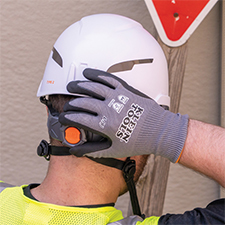
Keeping Your Hands Safe: The Cutting Edge of Glove Technology for Electrical Work
Chuck Ross
A few weeks back, I managed to slice a finger while rinsing out a tuna can for recycling. I generally don’t open cans all the way – I like to leave the lid attached so they aren’t loose in the bin as possible random cutting hazards. The event at my kitchen sink proved just how sharp their edges can be. I barely felt a thing, but it still took a week or two to fully heal, and it brought home to me just how quickly a slight loss of attention can cause an injury.
Certainly, the same thing is even more true at an electrical job site, where contractors can face a number of potential hazards to their hands from cuts or electrical shocks. That’s why gloves are such an important component in any personal protective equipment (PPE) strategy. Knowing what to look for when choosing new gear can help keep your hands – and the rest of the body their attached to – safe and injury-free.
When it comes to cutting hazards, safety gloves are tested according to how much force it takes to penetrate the fabric. So, at the lowest level, according to the ANSI testing standard, Cut Level A1 gloves can withstand 200-500 grams of cutting load, while at the high end, Level A9 gloves can stand up to a cutting load over 6,000 grams. To better understand what these limits mean, Level A1 protection is intended where cutting risk is low, as in warehouse work or assembling small parts, where A9 is meant for high-risk settings, such as meat processing or metal recycling plants. Electrical construction settings can call for protection between levels A3 and A5.
Rubber-insulated electrical safety gloves have their own safety ratings and testing procedures, with a color-coded classification system, starting with Class 00 Beige gloves for use where maximum voltages don’t exceed 500V AC or 750V DC and topping out with Class4 Orange gloves where maximum voltages are 36,000V AC or 54,000V DC. Additionally Type I electrical gloves are not ozone resistant, while Type II are ozone resistant.
Unfortunately, electrical gloves aren’t cut resistant – in fact, they should be tossed if they get cut or punctured in any way, because those openings leave a route for electrical current to reach your skin. So, safety experts recommend leather protector gloves be worn over electrical gloves where such damage could occur.
Certainly, the same thing is even more true at an electrical job site, where contractors can face a number of potential hazards to their hands from cuts or electrical shocks. That’s why gloves are such an important component in any personal protective equipment (PPE) strategy. Knowing what to look for when choosing new gear can help keep your hands – and the rest of the body their attached to – safe and injury-free.
When it comes to cutting hazards, safety gloves are tested according to how much force it takes to penetrate the fabric. So, at the lowest level, according to the ANSI testing standard, Cut Level A1 gloves can withstand 200-500 grams of cutting load, while at the high end, Level A9 gloves can stand up to a cutting load over 6,000 grams. To better understand what these limits mean, Level A1 protection is intended where cutting risk is low, as in warehouse work or assembling small parts, where A9 is meant for high-risk settings, such as meat processing or metal recycling plants. Electrical construction settings can call for protection between levels A3 and A5.
Rubber-insulated electrical safety gloves have their own safety ratings and testing procedures, with a color-coded classification system, starting with Class 00 Beige gloves for use where maximum voltages don’t exceed 500V AC or 750V DC and topping out with Class4 Orange gloves where maximum voltages are 36,000V AC or 54,000V DC. Additionally Type I electrical gloves are not ozone resistant, while Type II are ozone resistant.
Unfortunately, electrical gloves aren’t cut resistant – in fact, they should be tossed if they get cut or punctured in any way, because those openings leave a route for electrical current to reach your skin. So, safety experts recommend leather protector gloves be worn over electrical gloves where such damage could occur.
Photo courtesy of Klein Tools



